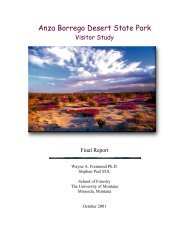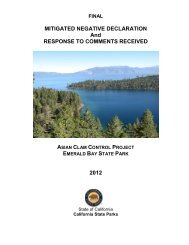Park Brochure - California State Parks
Park Brochure - California State Parks
Park Brochure - California State Parks
Create successful ePaper yourself
Turn your PDF publications into a flip-book with our unique Google optimized e-Paper software.
A<br />
nnadel <strong>State</strong> <strong>Park</strong> sits in the historic<br />
Valley of the Moon, an area popularized<br />
by author Jack London. This largely<br />
undeveloped park is 60 miles north of San<br />
Francisco on the eastern edge of Santa<br />
Rosa. The park has more than 5,500 acres<br />
of rolling hills, seasonal streams, meadows<br />
and woodlands free from modern intrusions.<br />
Summers are hot and dry, with<br />
temperatures often in the 90s and evening<br />
lows near 50 degrees. At times during the<br />
summer, coastal fog penetrates inland,<br />
providing cool evenings. Most of the area’s<br />
30 inches of rain occur from November to<br />
April. Wintertime low temperatures can<br />
drop to the mid-20s with daytime highs in<br />
the 50s or 60s.<br />
PARK HISTORY<br />
For thousands of years, the Southern<br />
Pomo lived near what is now the park. No<br />
permanent village sites have been found in<br />
the park, but these lands were important as<br />
trading grounds and as a source of obsidian,<br />
a volcanic rock that was traded with other<br />
tribes, who would work it into scrapers,<br />
knives, arrow points and spearheads.<br />
In the early 1800s, Russian and Aleutian<br />
fur trappers arrived in the area to establish<br />
Fort Ross, now a state historic park. They<br />
found the Pomo willing traders and hard<br />
workers. The Fort Ross settlers may have<br />
been the Pomo’s first contact with nonnative<br />
people. By the mid-1800s, many<br />
native people had been drawn into nearby<br />
Mission San Francisco Solano. Gold rush<br />
miners and settlers who wanted the Pomo<br />
lands forced the Pomo into indentured<br />
servitude (despite <strong>California</strong>’s prohibition<br />
against slavery) or moved them onto<br />
reservations. Though the Pomo resisted<br />
these drastic changes to their way of life,<br />
many succumbed to overwork and to<br />
European diseases to which they had<br />
no resistance.<br />
With the arrival of Europeans, cattle<br />
ranching and farming gradually replaced<br />
the native pattern of hunting and<br />
gathering. By 1837 this area had become<br />
part of Los Guilicos Rancho, a Mexican<br />
land grant covering about 19,000 acres.<br />
Eleven years later, the property was<br />
acquired by William Hood, who came here<br />
from his native Scotland.<br />
In the late 1800s, sheep and cattle grazing<br />
gave way to the quarrying of cobblestones.<br />
This was the major source of income for the<br />
Wymore and Hutchinson families, the area’s<br />
principal landowners, until the early 1900s.<br />
Cobblestones were used in the building of<br />
San Francisco and other west coast cities,<br />
as well as in their reconstruction after the<br />
1906 earthquake. However, cobblestone<br />
roads were not suitable for motor<br />
vehicles, and by the 1920s demand for<br />
them had significantly declined.<br />
In the 1930s, entrepreneur Joe Coney<br />
bought 3,200 acres of oak woodlands<br />
near Santa Rosa from Irish immigrant<br />
Samuel Hutchinson. Hutchinson had<br />
named his ranch by combining the name<br />
of his daughter, Annie, with dell (a small,<br />
secluded, wooded valley). Under the<br />
Coneys’ ownership, it became known<br />
as “the Annadel Farm.” Coney built a<br />
hunting and fishing retreat for his friends.<br />
He stocked the property with game<br />
birds and filled his man-made lake, Lake<br />
Ilsanjo (built in the mid-1950s and named<br />
for the Coney couple, Ilse and Joe), with<br />
black bass and other fish. When his<br />
fortunes began to diminish in the 1960s,<br />
Joe Coney decided to sell the ranch.<br />
<strong>California</strong> <strong>State</strong> <strong>Park</strong>s acquired Annadel in<br />
1971, and it became a state park in 1974.<br />
Ledson Marsh

















